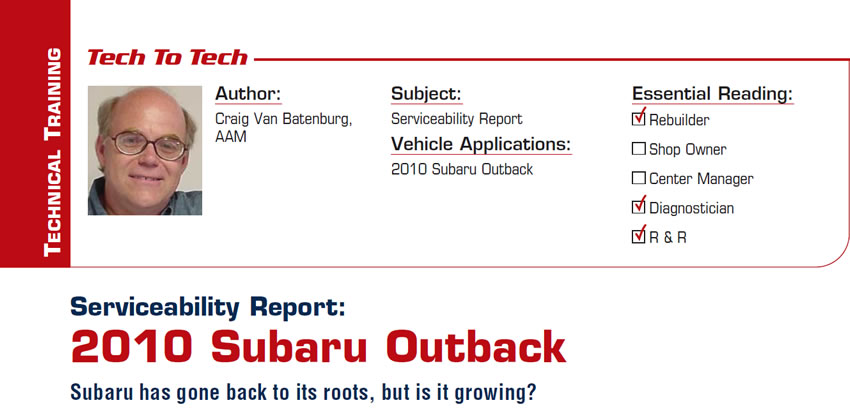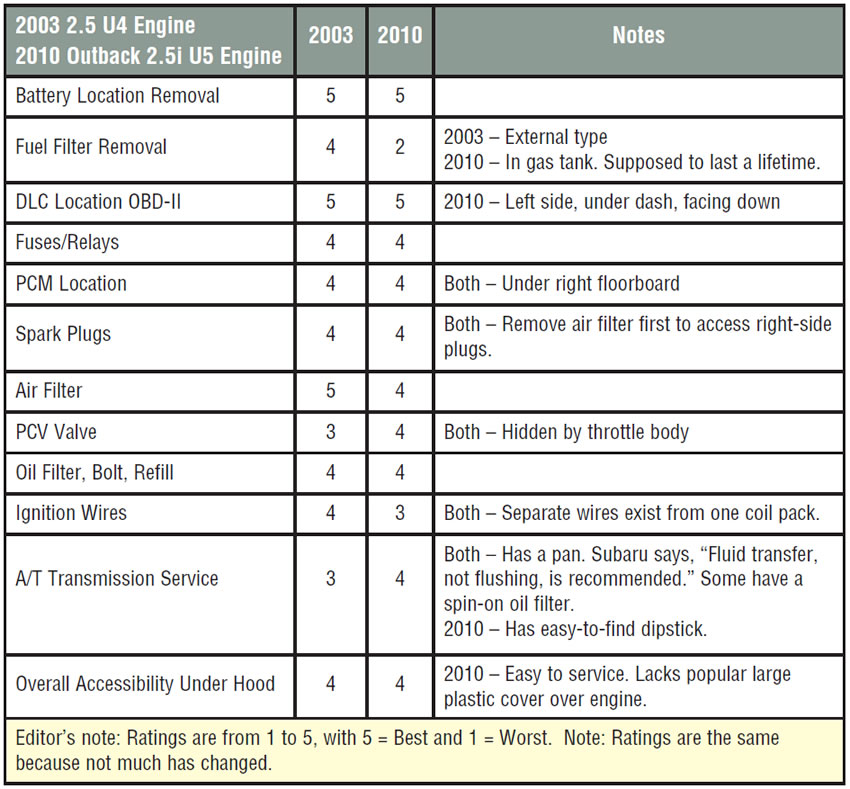
Tech-to-Tech
- Subject: Serviceability Report
- Vehicle Application: 2010 Subaru Outback
- Essential Reading: Rebuilder, Diagnostician, R & R
- Author: Craig Van Batenburg, AAM
Subaru has gone back to its roots, but is it growing?
I live in Massachusetts, where Subaru enjoys a lot of loyal fans. In my former repair shop, we worked on many Subaru models, and I witnessed firsthand the change from the company’s all-wheel-drive (AWD), quirky little cars to a more-generic line of front-wheel-drive cars along the lines of Honda and, lately, back to only AWD cars with attitude. I can also say that the owners will defend their cars even when they are breaking down and leaking oil. I owned a 1996 Subaru Outback wagon I bought used for one New England winter. It did its job, and the heated seats were a bonus. But after the head gaskets failed and new cylinder heads and a short block were in its future, we parted ways.
How good are the new Subarus?
Subaru got its start with a 360cc, two-cylinder, two-stroke, 22-horsepower weird micro-car built by Fuji Heavy Industries and exported to America starting in 1968. It cost $1,297, the engine was mounted in the rear and it got 66 miles per gallon. From there Subaru has built a decent brand and in the 1970s started to see its sales increase in some parts of the United States where car owners needed an AWD – but one cheap and small.
SUVs grew at a rapid pace in the 1990s. In 1995 Subaru claimed that the Outback was the “world’s first sports-utility wagon.” Designed for America, the Subaru Outback provided many SUV traits without some of its negative aspects. Based on its Legacy wagon, the Outback came standard with AWD, a raised suspension for better ground clearance and a unique interior and exterior.
The first Subaru Outback was a hit with consumers. Over the years, many other original-equipment manufacturers (OEMs) came up with similar crossover wagons and SUVs. By the year 2000, everyone was in the game but Subaru continued to raise the bar and now has a third-generation Outback for 2010.

Older Subaru Outback models
The original Subaru Outback model debuted in 1995 and was really a trim package on the Legacy wagon. In 1996, the Outback (officially known as the Legacy Outback for this generation) gained its raised suspension, large fog lights, SUV design cues and optional 155-hp, 2.5-liter engine.
The second-generation Subaru Outback (2000-2004) was available as either a sedan or a wagon. In its first year, this model was available in base and limited trims and had a 165-hp, 2.5-liter engine. The following year, Subaru introduced the L.L. Bean Edition and the vehicle-dynamics-control (VDC) trim levels. These featured the more-powerful 212-hp six-cylinder engine.

2010 Subaru Outback
The Outback is now available only as a station wagon. There are several trim levels: base 2.5i, 2.5i Special Edition, 2.5i Limited, 2.5 XT Limited and 3.0 R Limited. For power, the 2.5i has a 2.5-liter horizontally opposed four-cylinder engine that makes 170 hp. The XT adds a turbocharger to the 2.5 with 243 hp and 241 lb.-ft. of torque. The 3.0 R model comes with a 3.0-liter, horizontally opposed six-cylinder (H6) good for 245 hp and 215 lb.-ft. of torque.
All Outbacks come standard with all-wheel drive and stability control. Models with either of the 2.5-liter engines can be equipped with a five-speed manual transmission. A four-speed automatic is available on 2.5i models, while 2.5 XT models get a five-speed auto. The 2.5i Limited models are four-speed automatic only, and the H6 comes with only the five-speed automatic.
So how is the 2003 Subaru Outback 2.5L (second generation) in terms of service? This car had six safety recalls ranging from a faulty cruise-control cable to rust issues, a parking-rod problem and a water-pump pulley. In 2004, the engine was completely re-engineered, and in 2005 the body was redone. It took two model years for Subaru to right some wrongs, so by 2006 the Outback had been improved in many areas.
For 2004, Subaru was the top-ranked brand for reliability by Consumer Reports magazine. Subaru’s lineup averaged just eight problems per 100 vehicles based on surveys of Consumer Reports readers. That’s better than Honda at nine and Toyota and Acura at 10, but this did not translate to more sales.
Catalytic converters are a problem area, and many cars can give you code P0420. If you see this code, test first but don’t be surprised if you see a degraded catalytic converter. Check with the dealer on low-mileage cars, as there may be warranty consideration.
Servicing the 2010 Subaru Outback 2.5i
Subaru has enjoyed more success than most OEMs the past 12 months. In 2008, sales were up 0.3% over 2007 (that in a year when most carmakers were down as much as 20% to 30%). Subaru is up 3.4% so far this year over last. That’s impressive, to say the least.
The 2010 base model is rarely sold in New England, because the Special Edition has heated seats and many options that help tame the winter snow and ice. The five-passenger, off-road wagon is meant for those who take the weekends as an opportunity to explore the outdoors. It features a trick roof rack that’s standard. The roof rails integrate the twin crossbars on pivots, so when they’re not in use they swivel into line and reduce drag. Expect this feature to be a staple of the Outback for years to come and to be copied by many. A new continuously variable transmission (CVT) dubbed Lineartronic is an option. Both help save fuel.
As I normally do, I visited a Subaru dealership to talk parts and service. I spoke with Dan Catino of Patrick Motors, who had a fresh perspective, seeing as he is a 19-year-old graduate of Bay Path Technical High School. He had the right attitude.
I asked him, “What do you want to see in your bay first thing Monday morning – a 2003 or a 2010 Outback?”
He said, “The 2003.”
“Why,” I asked.
He replied, “Because I know that car.”
He started on flat rate recently and finds Subaru to his liking. He is proficient in re-flashing the electronic control units (ECUs) and has been to school for the SDS, the factory laptop-based scan tool.
If you have the training, correct tools and equipment; are computer literate; and can handle the complex electronics, most cars are OK to service. But Subaru is better than most, unless we talk about the turbo and boxer six. Those Subarus can make you wonder.
2003
- Ups – Simple to service. Fuel filter is outside the tank. Just enough problems to keep a tech busy.
- Downs – Rust is a problem in the northern states. Oil leaks and small things may make you wish that Subaru had learned some lessons from Honda about oil-tight cases.
2010
- Ups – Not enough has changed from 2003 to make you have to learn a whole new car. Subaru says quality is higher.
- Downs – Not much to complain about yet.

Craig Van Batenburg, AAM, is the owner of the Automotive Career Development Center (ACDC), www.autocareers.org, and delivers management and technical seminars nationwide. He formerly owned Van Batenburg’s Garage Inc. in Worcester, Mass., for more than 25 years. Van Batenburg is ASE master and L1 certified, with advanced skills in hybrid drive systems. You can reach him by e-mail at [email protected].
This copyrighted article is reprinted with the permission of AutoInc., the official publication of the Automotive Service Association (ASA). To learn more about ASA and its commitment to independent automotive-service and repair professionals, visit www.ASAshop.org or call 800-272-7467.













